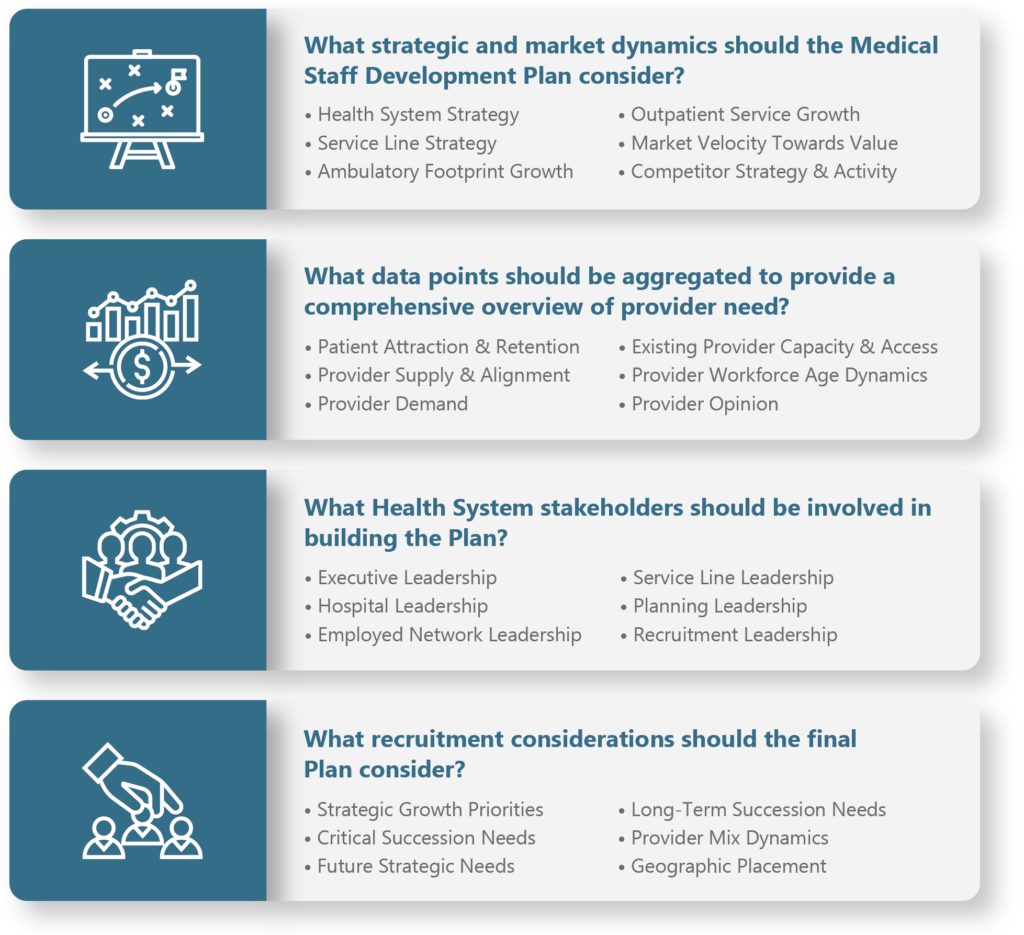Health System Medical Staff Development Planning: Improving Access, Building Provider Capabilities, and Facilitating Strategic Growth
Words from the Team
This whitepaper was created to outline what HSG considers to be best-practice for building a health system’s Medical Staff Development Plan (MSDP). In today’s environment, relying purely on evaluations of community need and piecing together a decentralized recruitment strategy will result in a disconnect between the strategic needs of a health system and its ability to execute through its provider workforce.
The Medical Staff Development Planning process should drive the centralization of provider strategy within a health system, and comprehensively identify the incremental provider recruitment and alignment opportunities that will ensure the health system is able to proactively execute its strategy. Given the demand for growth and the increasing push of care delivery to the outpatient and ambulatory setting, having a proactive provider development plan that is strongly tied to the execution of the health system’s strategic plan is critical.
We hope you find this whitepaper useful in evaluating and enhancing your current internal processes. If you need an outside perspective, HSG can partner with you to build and execute your MSDP strategy.
We hope you find this information useful and look forward to any feedback you have.
Download the Full White Paper or Read A Summary Below

|
Download a Digital Version of the White Paper |
Summary — Medical Staff Development Planning: Improving Access, Building Provider Capabilities, and Facilitating Growth
Many Health Systems are still approaching Medical Staff Development Planning with the “community need” mindset which includes some or all of the following behaviors:
- Evaluating provider need through the lens of one question: “Does our market have an under/oversupply of (insert specialty).” An alarming number of Health Systems ask this, and only this, question when considering provider need. The answer becomes the basis by which recruitment decisions are made – completely absent of the strategic context that Health Systems should be layering around their Medical Staff Development Planning decisions.
- Tasking decision making to a non-strategic “Medical Staff Development Planning” or “recruitment” committee that is not directly involved with the Health System’s strategic planning or integrated with the employed network’s management infrastructure.
- Assessing provider need on a three-year (or longer) time frame and not being responsive to changing market conditions and/or Health System needs.
- Assessing only physician need and not considering the role of the Advanced Practitioner as a strategic resource whose addition must be forecasted to drive access.
These behaviors result in recruitment plans disconnected from the strategy of the organization – resulting in unavailable provider resources to effectively serve strategic need.
Today’s healthcare environment demands that MSDPs evolve to a more strategic function given the importance of providers in the execution of a Health System’s overall strategy. Health Systems who are focusing on limited assessments of community need and then piecing their recruitment strategies together in a responsive fashion are setting themselves up for failure in driving strategic success.
Overall, the Medical Staff Development Plan must contemplate the question – “Can we provide access to the right provider, in the right location, at the right time, and with the right provider capability?”
HSG MSDP Framework

Benefits to the Health System of having a documented three-year plan include:
- Proactive, rather than reactive, recruitment to drive access and growth
- Operational planning to onboard and locate recruits
- More accurate budgetary planning
- The ability to meaningfully move Patient Share of Care and overall growth
Plans should be reviewed yearly, at a minimum, to account for progress, major changes in market dynamics, the impact of fortuitous recruitment not planned for, etc.
